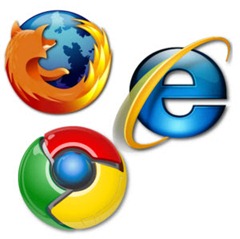
Previously:
Battle Of The Browser Updates
The latest and greatest versions of the three major Internet browsers have been released.
They are all streamlined and secure. Each has slightly different features, each has enthusiasts, each has its own world of add-ons that might make one preferable to another for you.
They all display web pages noticeably faster than previous versions. You’ll like that. Install any or all of them. (If you have more than one web browser installed, expect them to fight over which is to be the default.) If you can’t figure out why you’d care, don’t install any of them. You’ll wind up with IE9 eventually, but there’s no rush.
There is an interesting consistency in the program designs. However different they may be under the hood, each tries to deliver the most onscreen space possible for web pages.
The tops of the browsers can all be customized, but let’s compare them with something like their default settings – basic buttons, with no bookmarks or favorites displayed.
Internet Explorer 9
Firefox 4
Chrome 10
(Worth noting: unlike the others, Chrome is even more compact when run full-screen.)
If you look closely, you’ll see lots of cosmetic differences – the Home button is on the left or right; the Back button is big, medium, or small; the tabs are above or below or on the same line as the address bar. Firefox keeps the separate Search bar, while IE9 picks up Chrome’s unified bar for URLs and searches.
There is a small difference that’s so important to me that I might switch my default browser. There’s a button missing from Internet Explorer 9.
Microsoft doesn’t understand the importance of LastPass. There ought to be a LastPass button right here, next to the Home, Favorites, and Tools buttons.
(If you’re not familiar with LastPass, you should be. It is an essential tool for everyone. Go read my original article about it.)
LastPass works with Internet Explorer 9, of course. The problem is that it can’t be displayed without adding a row at the top of the screen that shouldn’t be necessary. Here’s what IE9 looks like with the LastPass toolbar.
That’s a waste of pixels. Microsoft has insisted on the purity of its Home / Favorites / Tools buttons at the expense of usability.
Is LastPass that important? Like many people, I cannot be online without it. Because of LastPass, I have different complex passwords for every website that requires a login. In our password-filled world, a password manager is a trusted friend that must be readily available all the time.
Sure, I can turn on the LastPass toolbar – but I hate wasted pixels!
One of Microsoft’s selling points for Internet Explorer 9 is a feature that integrates online services with Windows 7. When you “pin” a web-based service to your taskbar, the browser window is dedicated to that site, with its own jump list (the menu that pops up when you right-click the taskbar button), a dedicated button at the upper left to return to the service’s home page, and more. The idea is that the browser-based services will look and feel very much like programs installed on your computer, with as little distraction from the browser as possible. Here’s more information about pinned sites.
When you open a website from a pinned icon on the taskbar, all toolbars and add-ons are disabled. That’s by design, to prevent add-ons from interfering with the presentation of the web service. It’s impossible to use LastPass to log into a web service that is opened from a pinned icon on the taskbar. But that is exactly when I need it! I want a taskbar icon for Autotask, my online ticketing system; for GFIMax Remote Management, the dashboard that runs my monitoring service; for LogMeIn Central and LogMeIn Rescue, the services that I use for remote support. All of those services require complex passwords that I don’t remember because LastPass takes care of logging me in – unless I pin them to the taskbar, in which case LastPass is disabled.
There are other people asking for Microsoft to make a special exception for LastPass. It’s not impossible that this will change. At the moment, though, I look at 15 or 20 wasted pixels at the top of Internet Explorer 9 and it’s like an itch – I can’t stop noticing it.
Google Chrome is really, really fast. It was easy to set it up so my bookmarks are synced among my computers. That missing LastPass button might have me clicking the button to make Chrome my default browser.







I love IE because of the minimal interface. Unfortunately, I love LastPass more. Microsoft’s stupid intransigence loses them another customer. Bye-bye, IE. Hello, Firefox.
Completely agree with your assessment – IE9 would be my browser of choice if there were better accommodation for LastPass. Right now it’s just too annoying…
I am not sure if it was included in your article, but, while IE 9 does not work on windows xp, both Firefox and Chrome can be used on windows xp.
Part of Microsoft’s not-so-secret plan to move people away from Windows XP and make them feel pressured to buy a new computer. The most recent version of Windows Live Essentials (Photo Gallery, et al.) also can’t be installed on XP. I think that will be Microsoft’s course going forward, but it’s harder to predict how many other vendors will follow along. Not Google or Mozilla, so far.